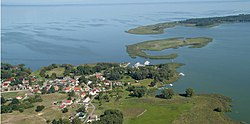Szczecin Lagoon



Szczecin Lagoon(Polish:Zalew Szczeciński,German:Stettiner Haff), also known asOder Lagoon(German:Oderhaff), andPomeranian Lagoon(German:Pommersches Haff), is alagoonin theOderestuary, shared byGermanyandPoland.It is separated from thePomeranian Bayof theBaltic Seaby the islands ofUsedomandWolin.The lagoon is subdivided into theKleines Haff(Polish:Mały Zalew,"small lagoon" ) in the West and theWielki Zalew(German:Großes Haff,"great lagoon" ) in the East. An ambiguous historical German name wasFrisches Haff,which later exclusively referred to theVistula Lagoon.[1]
Geography
[edit]

From the South, the lagoon is fed by several arms of theOderriver and smaller rivers likeZiese,Peene,Zarow,Uecker,andIna.[2]In the North, the lagoon is connected to theBaltic Sea'sBay of Pomeraniawith the three straitsPeenestrom,ŚwinaandDziwna,which divide the mainland and the islands ofUsedomandWolin.
The lagoon covers an area of 687 km2,its natural depth is an average 3.8 metres, and 8.5 metres at maximum.[3]The depth of shipping channels however can exceed 10.5 metres.[3]Thus, the lagoon holds about 2.58 km3of water.[4]The annual average water temperature is 11 °C.[4]
94% of the water loads discharged into the lagoon are from theOderriver and its confluences, amounting to an average annual 17 km3or 540 m3per second.[5]All other confluences contribute a combined annual 1 km3.[5]Since no reliable data for an inflow from theBaltic Seaexist, the combined inflow is an estimated 18 km3from a catchment area of 129,000 km2,residing in the lagoon for an average 55 days before being discharged into thePomeranian Bay.[4]Thenutrientsthereby transported into the lagoon have made ithyper(eu)trophictoeutrophic.[6]The straitsPeenestrom,ŚwinaandDziwnaare responsible for 17%, 69%, and 14% of the discharge, respectively.[7]
The averagesalinityis between 0.5 and 2 grams of salt per kilogram of water (approximately equivalent to 0.5 and 2parts per thousand[ppt]). Occasionally northerly winds reverse the direction of the Świna, admitting sea water from the Baltic Sea into the lagoon, raising the local salinity to 6 ppt.[5]
Towns around the Lagoon
[edit]- Szczecin(Poland)
- Świnoujście(Poland)
- Police(Poland)
- Ueckermünde(Germany)
- Wolin(Poland)
- Usedom(Germany)
- Nowe Warpno(Poland)
History
[edit]
In the 10th century, the emerging Polish state strove for the area, but likely did not succeed with establishing control.[8] Following Poland's fragmentation, it formed part of theDuchy of Pomerania.In the 17th century, it passed toSweden.Later on, it gradually passed to theKingdom of Prussiain the 18th and 19th century, and from 1871 was part of unifiedGermany.In 1880, theKaiserfahrt( "Emperor's passage" ) channel on Usedom was opened, a water route with a depth of 10 metres connecting the lagoon with the Baltic Sea by bypassing the eastern part of the Swine, allowing large ships to enter the lagoon and the seaport of Stettin quicker and safer.
The canal, approximately 12 km long and 10 metres deep, was dug by theGerman Empirebetween 1874 and 1880, during the reign of the firstKaiser Wilhelm(1797–1888) after whom it was named. Also, the work resulted in a new island namedKaseburg(Karsibór) being cut off from Usedom.
After the defeat ofNazi GermanyinWorld War IIin 1945, the eastern part of the lagoon became part of Poland, while the western part became part ofEast Germany.TheKaiserfahrtwas renamedPiast Canal,after the PolishPiast dynasty,which first included the region to Poland in the 10th century.
The German-Polish border also divides the bight calledNeuwarper SeenearRieth,Luckow.
Economy
[edit]
The lagoon has served as an important fishing grounds for centuries, as a major transportation pathway since the 18th century, and as a tourist destination since the 20th century.[3]
Heringsdorf AirportonUsedomisland is located on the shores of the lagoon.
Nature
[edit]The southern shore of the lagoon belongs to theAm Stettiner Haff Nature Park,its northern shore and the island of Usedom to theUsedom Island Nature Park.To the west is theAnklamer Stadtbruch Nature Reserveand, within it, theAnklamer Torfmoor,a protected wetland which is renaturalising after being used forpeatextraction.
See also
[edit]53°48′16″N14°08′25″E/ 53.80444°N 14.14028°E
References
[edit]- ^Erhard Riemann, Alfred Schoenfeldt, Ulrich Tolksdorf, Reinhard Goltz, Akademie der Wissenschaften und der Literatur (Germany), Akademie der Wissenschaften und der Literatur, Mainz,Preussisches Wörterbuch: Deutsche Mundarten Ost- und Westpreussens,6th edition, Wachholtz, 1974, p.595,ISBN3-529-04611-6
- ^Gerald Schernewski,Baltic coastal ecosystems: structure, function, and coastal zone management,Springer, 2002, p.79,ISBN3-540-42937-9
- ^abcUlrich Schiewer,Ecology of Baltic coastal waters,Springer, 2008, p.115,ISBN3-540-73523-2
- ^abcUlrich Schiewer,Ecology of Baltic coastal waters,Springer, 2008, p.117,ISBN3-540-73523-2
- ^abcUlrich Schiewer,Ecology of Baltic coastal waters,Springer, 2008, p.116,ISBN3-540-73523-2
- ^Ulrich Schiewer,Ecology of Baltic coastal waters,Springer, 2008, p.118,ISBN3-540-73523-2
- ^Ulrich Schiewer,Ecology of Baltic coastal waters,Springer, 2008, p.119,ISBN3-540-73523-2
- ^Edward Włodarczyk."Krótkie spojrzenie na dzieje Pomorza"(in Polish).Retrieved2023-09-15.
External links
[edit]- Glasby GP, Szefer P, Geldon J, Warzocha J (September 2004). "Heavy-metal pollution of sediments from Szczecin Lagoon and the Gdansk Basin, Poland".Sci. Total Environ.330(1–3): 249–69.Bibcode:2004ScTEn.330..249G.doi:10.1016/j.scitotenv.2004.04.004.PMID15325172.
- Lagoons of Europe
- Baltic Sea
- Bodies of water of Poland
- Lagoons of Mecklenburg-Western Pomerania
- Landforms of West Pomeranian Voivodeship
- Nature parks in Mecklenburg-Western Pomerania
- Parks in West Pomeranian Voivodeship
- Natura 2000 in Germany
- Natura 2000 in Poland
- International lakes of Europe
- Germany–Poland border
- Lakes of Poland

